It is possible to specify the pronunciation of a Chinese character by presenting a homophone (a word pronounced identically). This is feasible because the syllabic range of the Chinese language is quite limited. The syntactic pattern is X yin Y 甲音乙 "A has the [same] sound as B".
This method is normally used for uncommon characters, like in the phrase zhao yin zhao 釗音招, where 釗 is a relatively rare character, whose pronunciation (zhāo) is identical with that of the frequently used word 招. The operation of indicating the pronunciation of a character is called zhuyin 注音 "remarks to the sound".
The homophone system appeared in the late Han period 漢 (206 BCE-220 CE). Yan Shigu 顏師古 (581-645), the Tang-period 唐 (618-907) commentator of the history book Hanshu 漢書, written during the early later Han period, quotes the phonetic remarks of 23 writers to the text. The earliest of these were Fu Qian 服虔 and Ying Shao 應劭 (d. c. 203 CE). Some writers wrote specialized phonetic commentaries on ancient books. One of the earliest known comments of this type are Tang Xuandu's 唐玄度 Xinjia jiujing ziyang 新加九經字樣 from the Tang period, or Zhishan's 智善 Chunqiu zhiyin 春秋直音 from the Song period 宋 (960-1279). During the Ming period 明 (1368-1644), Zhang Fu 章黼 assembled all characters used as homophonic words for phonetic indication from the Han period on. His book is called Zhiyinpian 直音篇.
Somewhat older than the "direct [indication] of the sound" (zhiyin 直音) was the presentation of a character read in a similar way, with the syntax pattern X du ruo Y 甲讀若乙 "A is read like B". The du ruo system was not as exact as the zhiyin system and often only presented characters read in a similar, bit not necessarily in exactly the same way. In Modern Chinese, whose sound system is substantially reduced in comparison to Ancient Chinese, the difference is not that great, but 2,000 years ago the range of sounds was wider. Example from the core text of the late Han dictionary Shuowen jiezi 說文解字.
| 【珣[sĭuĕn˥˩]】讀若宣[sĭwɛn˥˩]。 | 珣 (actual pronuciation /sĭuĕn˥˩/) is read like 宣 /sĭwɛn˥˩/. |
| 【玖[kĭəu˥]】讀若芑[kʰĭə˥]。 | 玖 is read like 芑 /kʰĭə˥/. |
| 【闖[ţʰĭĕm˩˥]】讀若郴[ţʰĭĕm˥˩]。 | 闖 is read like 郴 /ţʰĭĕm˥˩/. |
Very interesting in this context is the fact that during the Han period the explanation of words with homophones was also used in the philosophical and cosmological sphere, as can be seen in the following examples from the late Han glossary Shiming 釋名.
| 霜[ʃĭaŋ˥˩],喪[sɑŋ˥˩]也。其氣慘毒,物皆喪也。 | Hoarforst means 'burial', because its energy is lethal, and all things (i.e. plants) will be buried. |
| 雪[sĭwɛt],綏[swi˥˩]也。水下遇寒氣而凝,綏綏然也。 | Snow means 'tranquil', because water, running down, will encounter cold energies and will freeze, so that it is totally tranquil. |
| 昏[xuən˥˩],損[suən˥]也,陽精損滅也。 | Dusk means 'reduced', because the essence of the male energy is dwindling. |
| 汁[tɕĭĕp],涕[tʰiei˩˥]也,涕涕而出也。 | Sap means 'tear', because it leaks out in single drops. |
The most famous of these wordplays are the explanations for the Confucian terms with the help of homophone words, as quoted in the ritual Classic Liji 禮記.
| 仁[nʑĭĕn˩] 者,人[nʑĭĕn˩] 也。 "Benevolence means [to act as] a human." |
| 禮[liei˥] 也者,理[lĭə˥] 也。 "Rituals mean orderliness." |
| 義[ŋĭe˩˥] 者,宜[ŋĭe˩] 也。 "Righteousness means to act appropriately." |
The Qing-period 清 (1644-1911) scholar Chen Li 陳澧 (1810-1882) points in his book Qieyun kao 切韻考 at a critical shortcoming of the zhiyin method: If there was no homophone, the method would not work, and if any existing homophone was a rare character just as the one to comment on, it would work neither. The dictionary Guangyun 廣韻, for instance, presents the character zhe /ʑĭɛt/ 折, but is not able to present a homophone character, because there is none. In the same book, there are seven homophones to the character che /tɕʰĭɛt/ 掣, but all of them are extremely rare (瘛, 懘, 痸, 𤸪, 𢜳, 銐, 𤢻), and need phonetic comments themselves.
The system is nevertheless very helpful and easy, and is therefore still in use today. An alternative, the fanqie system 反切 (indicating initial and final sound of a word by two different homophones, like, dong, du zong qie 冬,都宗切, [d-] and [-ʊŋ˥˩] for [dʊŋ˥˩]) developed during the Tang period), is more exact, but has a very scholarly touch.
Today, dictionaries and lexicons in the People's Republic use the alphabetic Pinyin system 拼音 in addition to indicate the pronunciation of rare characters or in case of special readings (like 【張臶(zūn尊)】 to explain the pronunciation of the character 臶, which is normally read jiàn).
In the two problematic cases described above, modern dictionaries and lexicons use characters with a very close pronunciation and a different tone pitch. It was first used by Tang Xuandu in the Tang period, who indicated the pronunciation of kong /kʰuŋ˩˥/ 控 by the words kōng qù 空去, meaning 控 is pronounced like kong /kʰuŋ˥˩/ 空, but in the falling tone pitch (qu 去), i.e. kòng. He furthermore described the sound of zhe /ʑĭɛt/ 折 as 旃 /tɕĭɛn˥˩/, but with the entering, final-consonant tone pitch (rusheng 入聲), i.e. tɕĭɛt.
The highlight of lexicography, the dictionary Kangxi zidian 康熙字典, uses both the fanqie system and the "direct sound indication", and where the latter was not applicable, presents an alternative with a different tone pitch, like 寡, pronounced like 瓜 kwa˥˩, but with the slowly rising tone pitch (shangsheng 上聲), i.e. kwa˩˥.
Characters serving as paradigms for pronunciation were derived either from classical writings that everone knew by heart, as the Shijing 詩經 "Book of Songs", or from common expressions. Phonetic commentaries were/are furthermore necessary when characters had several different pronunciations, like 奇 (gʰĭe˩ and kĭe˥˩) or 行 (ɣɐŋ˩, ɣɑŋ˥˩, ɣɑŋ˩, and ɣɐŋ˩˥). In many cases, commentators wrote combined notes on phonetics and semantic issues (yinyi 音義, yinshi 音釋 or yinbian 音辨). This was necessary when different readings of characters resulted in grammatical problems (like 為, which is read wèi "for, as" or wéi "to do, to act as, to be"), or in case characters were used in a wrong way or as loan characters, like zhāo 招 "to raise" instead of qiào 翹 "to elevate", or tiào 跳 "to jump" instead of táo 逃 "to flee".
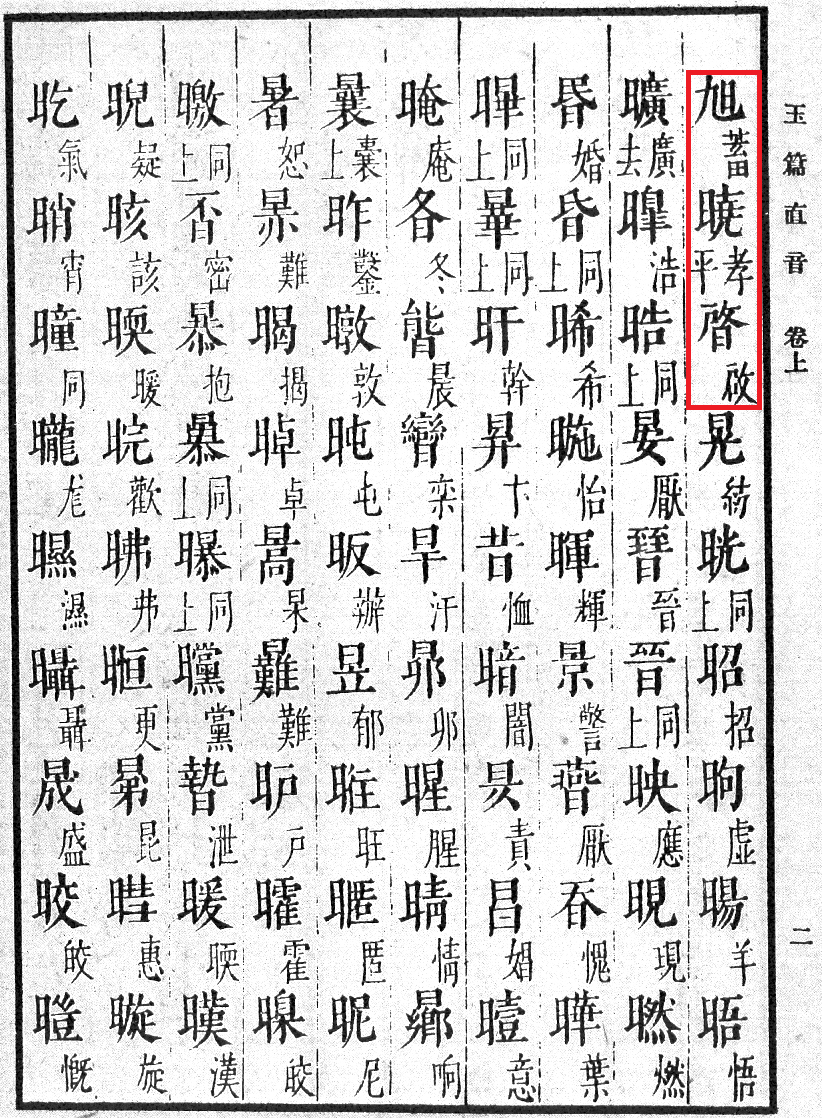 |
Yupian zhiyin 玉篇直音, an phonetic list of characters used in the dictionary Yupian 玉篇 by Gu Yewang 顧野王 (Liang period). The page shown (from the radical 日 "sun") begins with the words 旭 (read like 蓄), 曉 (read like 孝, but in the level tone), and 晵 (read like 啟). |
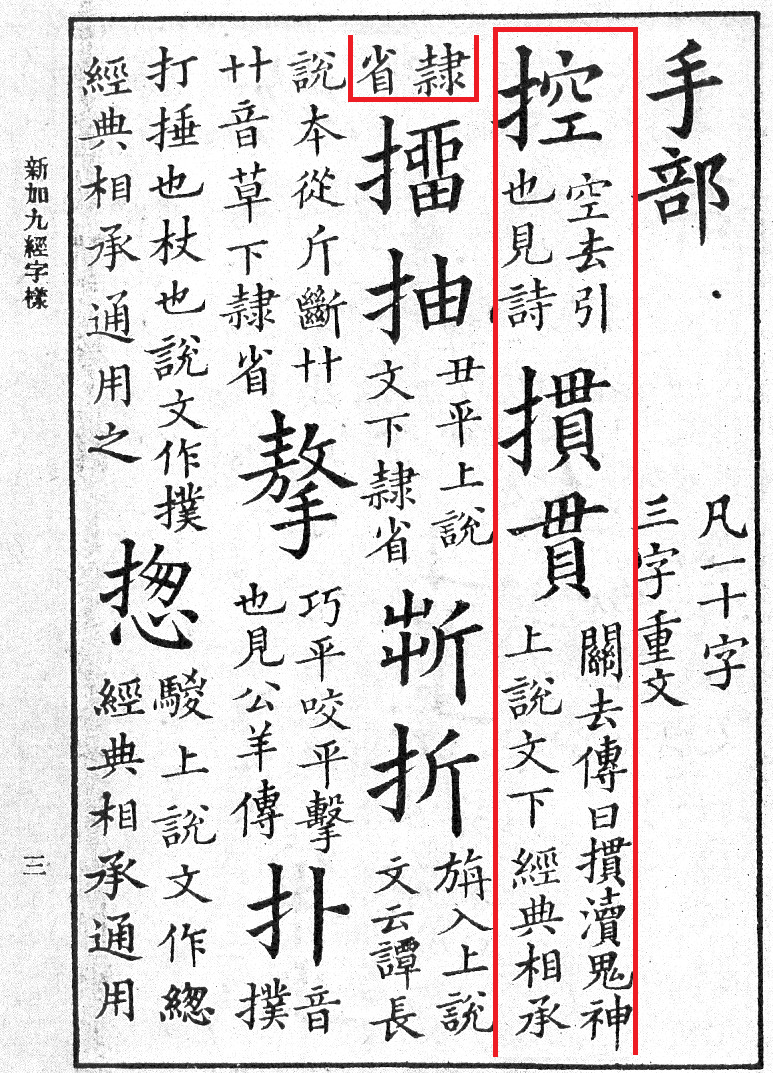 |
Xinjia jiujing ziyang 新加九經字樣, phonetic remarks to characters used in the Classics by Tang Xuandu 唐玄度 (Tang period). The example shown is from the section of the radical 手 "hand". It begins with the words 控 (read like 空, but in the falling tone, and means "to draw", see the [Classic] Shijing 詩經.) and 摜貫 (read like 關, but in the falling tone. The [Classic] [Zuo]zhuan 左傳 says: Guandu guishen 摜瀆鬼神. The first character is used in the [dictionary] Shuowen [jiezi] 說文解字, the lower one is the abbreviated shape in the standard script li[shu] 隸書 as used in the transmitted versions of the Classics.) |
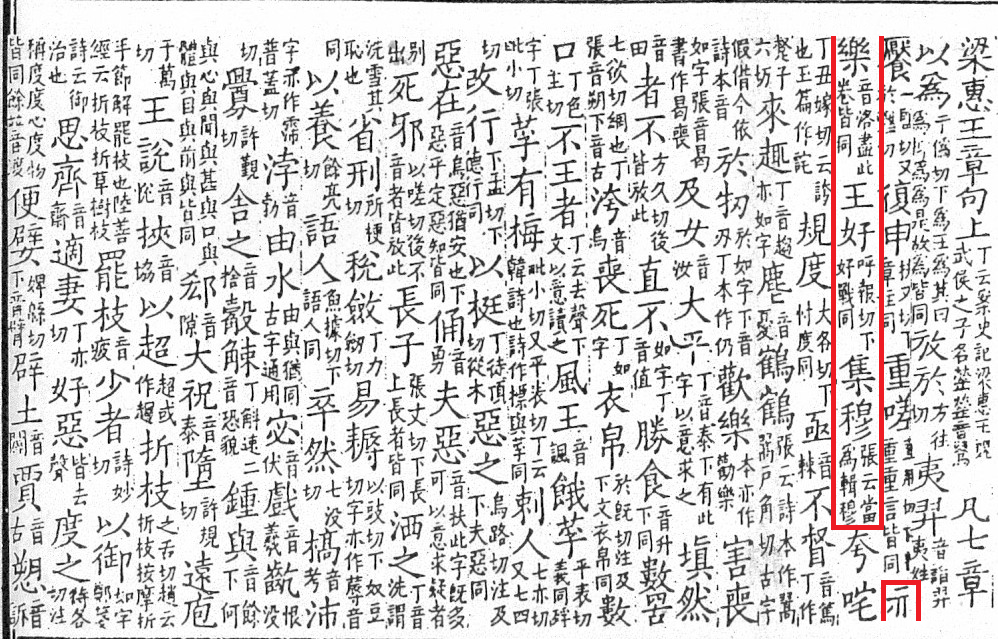 |
Mengzi yinyi 孟子音義, a phonetic commentary to the Classic Mengzi 孟子 by Sun Shi 孫奭 (Song period), from the collection Tongzhitang jingjie 通志堂經解. The example is from the chapter Liang Huiwang 梁惠王. Some characters of the first and second column are unfortunately not readable. The remark to the first expression in the third columns, 亦樂, says that the character 樂 is pronounced like 洛 throughout the whole chapter. The second commentary, to 王好, says that 好 is read 呼報切 (fanqie system), idem in the expression 好戰 further below. In the next character pair, 集穆, the first one is identified as a loan character for 輯, as a commentator Zhang 張 believes. |
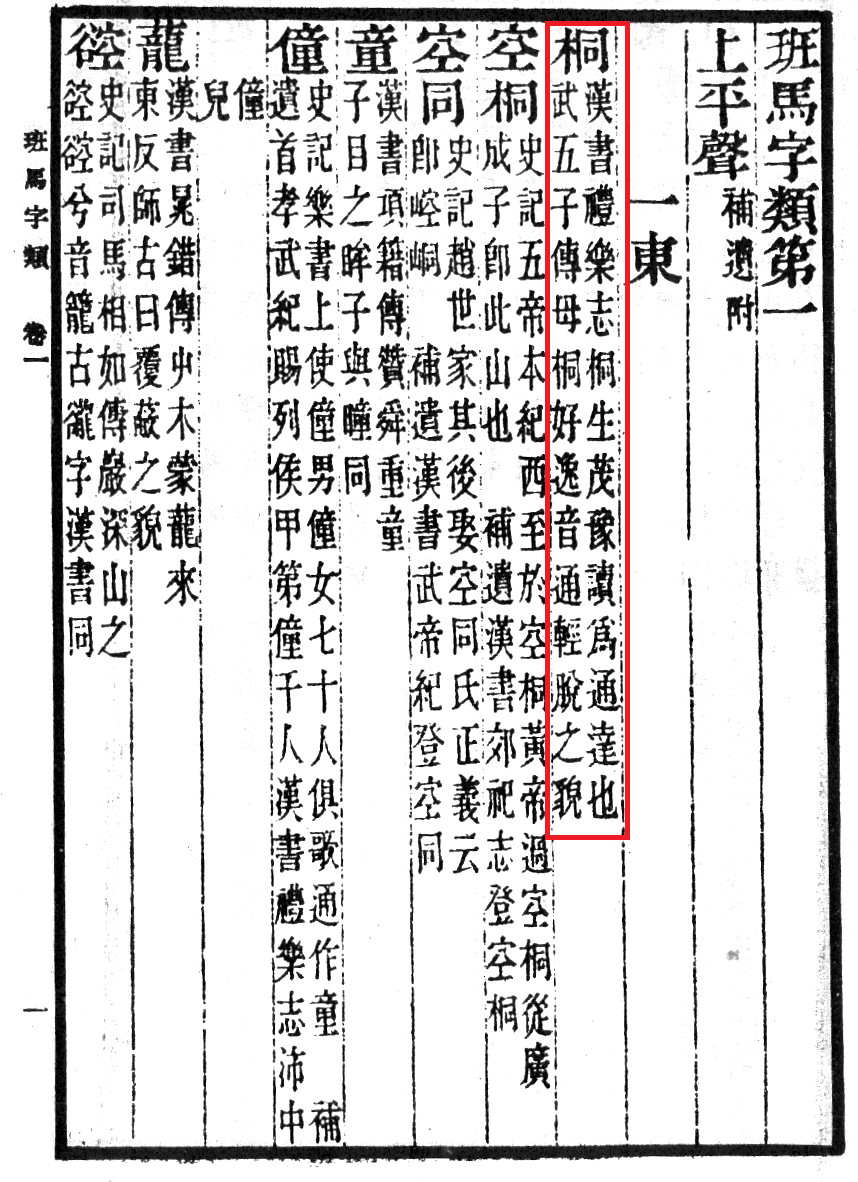 |
Ban-Ma zilei 班馬字類, compiled by Lou Ji 婁機 (Song period), phonetic remarks to characters used in the history books Hanshu 漢書 by Ban [Gu] 班固 and Shiji 史記 by [Si]ma [Qian] 司馬遷 (note that the chronological order in which the books were written is reversed). The glossary is arranged according to the Guangyun 廣韻 rhyme system, beginning with the rhyme group [-uŋ], in the example [dʰuŋ]. It first quotes phrases from Hanshu or Shiji chapters, and then explains phonetic peculiarities of words. The word 桐, for instance, is used in the same sense as 通 "to go through, to arrive" in a Hanshu passage, and with the meaning of 輕脫 "to treat thoughtlessly" in a Shiji chapter (also pronounced like 通). |
During the Republican period (1911-1949) a modern system was developed for indicating the pronunciation of characters with the help of homophones. It is used in the Guoyu cidian 國語辭典 (ed. by Zhongguo da cidian bianzuan chu 中國大辭典編纂處, [Taibei:] Taiwan shangwu yinshuguan, 1965 [1st ed. 1922, Shanghai: Shanghai shangwu yinshuguan]). In this dictionary (despriction see Guoyu cidian fanli 國語辭典凡例, 5.), homophones (without considering the tone pitch) are presented in square boxes (zhiyin fangkuai 直音方塊), and the one pitch is indicated by dots and circles in the four corners of this box. A black dot (like ‧) to the lower left indicates the first, level tone (yinping 陰平), a circle (like °) to the lower left the second, rising tone (yangping 陽平), a circle to the upper left the third, slowly rising tone (shangsheng 上聲), and a circle to the upper right the fourth, falling tone (qusheng 去聲). A dot in the lower right corner indicates the existence of a closing consonant in earlier pronunciation and dialects (rusheng 入聲).
bā  |
bá  |
bǎ  |
bà  |
bat  |
道 dào read like  (dāo 刀 in the falling pitch) (dāo 刀 in the falling pitch) |
到 dào read like  (dāo 刀 in the falling pitch) (dāo 刀 in the falling pitch) |
刀 dāo read like  (到 dào in the raising pitch, should be: level) (到 dào in the raising pitch, should be: level) |
八 bā read like  (bā 巴 with consonant ending [t]) (bā 巴 with consonant ending [t]) |
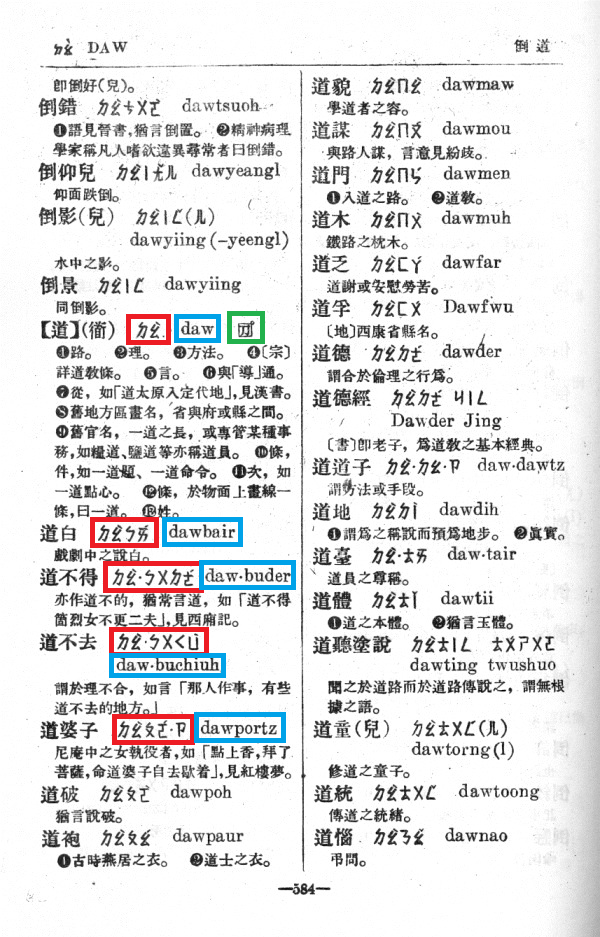 |
Example from the dictionary Guoyu cidian 國語辭典 (1937-1947), where the pronunciation of characters is indicated by using not only the Zhuyin 注音 (red) and the Gwoyeu Romatzyh 國語羅馬字 (blue) systems, but also a square box with a dot or circle indicating the tone pitch (green). |
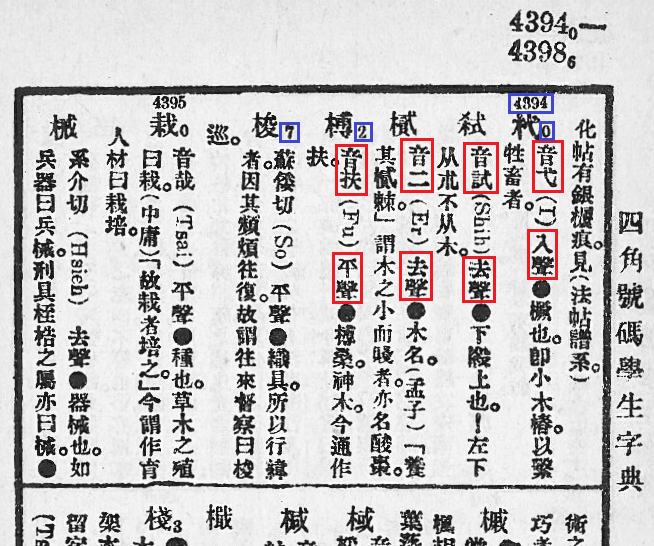 |
Example from the dictionary Sijiao haoma xuesheng zidian 四角號碼學生字典 (1928), where the pronunciation of characters is indicated by using not only the Wade-Giles system, but also a homophone and by additionally indicating the tone pitch, like: 杙 (音弋,入聲), 弑 (音試,去聲), 樲 (音二,去聲), 榑 (音扶,平聲). Yet for the next character 梭, the fanqie system 反切 is used (蘇倭切, because there is no homophone character), along with an indication to the tone pitch (平聲). |
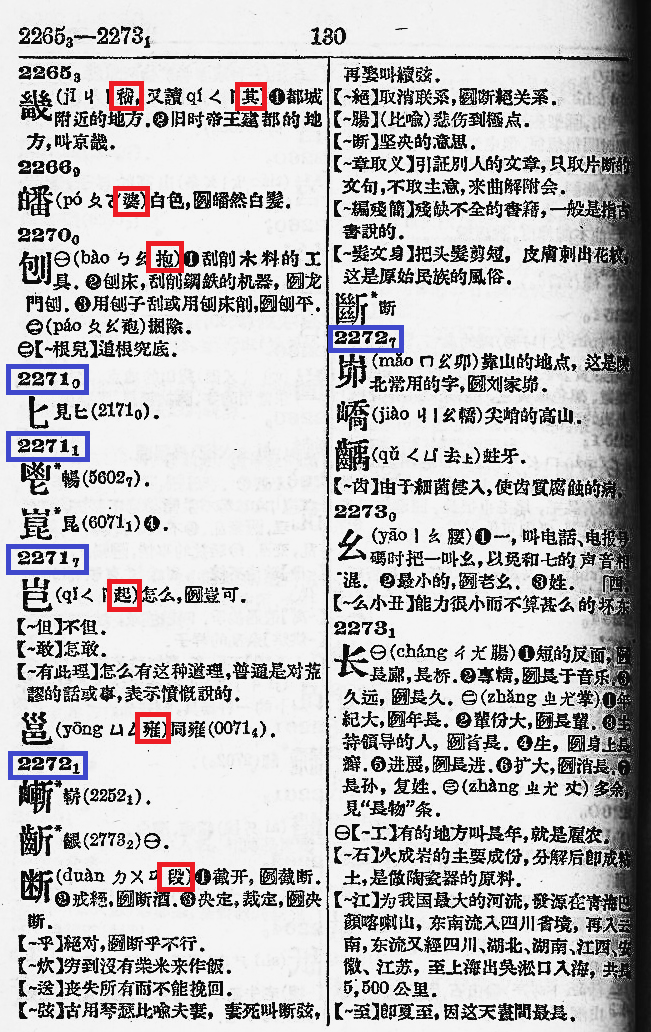 |